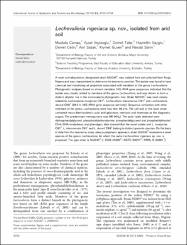| dc.contributor.author | Camas, Mustafa | |
| dc.contributor.author | Veyisoğlu, Ayşel | |
| dc.contributor.author | Tatar, Demet | |
| dc.contributor.author | Saygin, Hayrettin | |
| dc.contributor.author | Çetin, Demet | |
| dc.contributor.author | Sazak, Anıl | |
| dc.contributor.author | Şahin, Nevzat | |
| dc.date.accessioned | 2019-10-20T08:00:11Z | |
| dc.date.available | 2019-10-20T08:00:11Z | |
| dc.date.issued | 2013 | |
| dc.identifier.issn | 1466-5026 | |
| dc.identifier.issn | 1466-5034 | |
| dc.identifier.uri | https://dx.doi.org/10.1099/ijs.0.052266-0 | |
| dc.identifier.uri | https://hdl.handle.net/11421/15979 | |
| dc.description | WOS: 000327910200034 | en_US |
| dc.description | PubMed ID: 23645016 | en_US |
| dc.description.abstract | A novel actinobacterium, designated strain NJ2035(T), was isolated from soil collected from Abuja, Nigeria and was Characterized to determine its taxonomic position. The isolate was found to have chemical and morphological properties associated with members of the genus Lechevalieria. Phylogenetic analyses based on almost-complete 16S rRNA gene sequences indicated that the isolate was closely related to members of the genus Lechevalieria, and was shown to form a distinct phyletic line in the Lechevalieria phylogenetic tree. Strain NJ2035(T) was most closely related to Lechevalieria roselyniae C81(T), Lechevalieria atacamensis C61(T) and Lechevalieria deserti C68(T) (98.5 % 16S rRNA gene sequence similarity). Sequence similarities with other members of the genus Lechevalieria were less than 98.2 %. The cell wall of the novel strain contained meso-diaminopimelic acid, and galactose, mannose and rhamnose as the diagnostic sugars. The predominant menaquinone was MK-9(H-4). The polar lipids detected were diphosphatidylglycerol, phosphatidylethanolamine, phosphatidylglycerol and phosphatidylinositol. DNA DNA relatedness and phenotypic data showed that the novel isolate and L. roselyniae C81(T), L. atacamensis C61(T) and L. deserti C68(T) belong to distinct genomic species. On the basis of data from this taxonomic study using a polyphasic approach, strain NJ2035(T) represents a novel species of the genus Lechevalieria, for which the name Lechevalieria nigeriaca sp. nov. is proposed. The type strain is NJ2035(T) (=DSM 45680(T)=KCTC 29057(T)=NRRL B-24881(T)). | en_US |
| dc.description.sponsorship | Ondokuz Mayis University (OMU) [PYO. FEN. 1901.09.003] | en_US |
| dc.description.sponsorship | This research was supported by Ondokuz Mayis University (OMU), project no. PYO. FEN. 1901.09.003. | en_US |
| dc.language.iso | eng | en_US |
| dc.publisher | Soc General Microbiology | en_US |
| dc.relation.isversionof | 10.1099/ijs.0.052266-0 | en_US |
| dc.rights | info:eu-repo/semantics/openAccess | en_US |
| dc.title | Lechevalieria nigeriaca sp nov., isolated from arid soil | en_US |
| dc.type | article | en_US |
| dc.relation.journal | International Journal of Systematic and Evolutionary Microbiology | en_US |
| dc.contributor.department | Anadolu Üniversitesi, Fen Fakültesi, Biyoloji Bölümü | en_US |
| dc.identifier.volume | 63 | en_US |
| dc.identifier.startpage | 3750 | en_US |
| dc.identifier.endpage | 3754 | en_US |
| dc.relation.publicationcategory | Makale - Uluslararası Hakemli Dergi - Kurum Öğretim Elemanı | en_US |


















